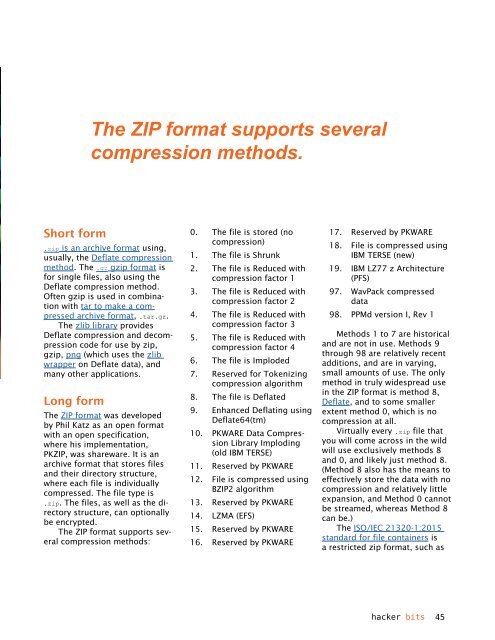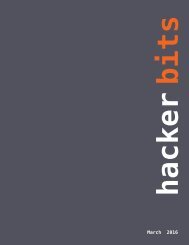Hacker Bits, August 2016
HACKER BITS is the monthly magazine that gives you the hottest technology stories crowdsourced by the readers of Hacker News. We select from the top voted stories and publish them in an easy-to-read magazine format. Get HACKER BITS delivered to your inbox every month! For more, visit https://hackerbits.com/2016-08.
HACKER BITS is the monthly magazine that gives you the hottest technology stories crowdsourced by the readers of Hacker News. We select from the top voted stories and publish them in an easy-to-read magazine format.
Get HACKER BITS delivered to your inbox every month! For more, visit https://hackerbits.com/2016-08.
Create successful ePaper yourself
Turn your PDF publications into a flip-book with our unique Google optimized e-Paper software.
The ZIP format supports several<br />
compression methods.<br />
Short form<br />
.zip is an archive format using,<br />
usually, the Deflate compression<br />
method. The .gz gzip format is<br />
for single files, also using the<br />
Deflate compression method.<br />
Often gzip is used in combination<br />
with tar to make a compressed<br />
archive format, .tar.gz.<br />
The zlib library provides<br />
Deflate compression and decompression<br />
code for use by zip,<br />
gzip, png (which uses the zlib<br />
wrapper on Deflate data), and<br />
many other applications.<br />
Long form<br />
The ZIP format was developed<br />
by Phil Katz as an open format<br />
with an open specification,<br />
where his implementation,<br />
PKZIP, was shareware. It is an<br />
archive format that stores files<br />
and their directory structure,<br />
where each file is individually<br />
compressed. The file type is<br />
.zip. The files, as well as the directory<br />
structure, can optionally<br />
be encrypted.<br />
The ZIP format supports several<br />
compression methods:<br />
0. The file is stored (no<br />
compression)<br />
1. The file is Shrunk<br />
2. The file is Reduced with<br />
compression factor 1<br />
3. The file is Reduced with<br />
compression factor 2<br />
4. The file is Reduced with<br />
compression factor 3<br />
5. The file is Reduced with<br />
compression factor 4<br />
6. The file is Imploded<br />
7. Reserved for Tokenizing<br />
compression algorithm<br />
8. The file is Deflated<br />
9. Enhanced Deflating using<br />
Deflate64(tm)<br />
10. PKWARE Data Compression<br />
Library Imploding<br />
(old IBM TERSE)<br />
11. Reserved by PKWARE<br />
12. File is compressed using<br />
BZIP2 algorithm<br />
13. Reserved by PKWARE<br />
14. LZMA (EFS)<br />
15. Reserved by PKWARE<br />
16. Reserved by PKWARE<br />
17. Reserved by PKWARE<br />
18. File is compressed using<br />
IBM TERSE (new)<br />
19. IBM LZ77 z Architecture<br />
(PFS)<br />
97. WavPack compressed<br />
data<br />
98. PPMd version I, Rev 1<br />
Methods 1 to 7 are historical<br />
and are not in use. Methods 9<br />
through 98 are relatively recent<br />
additions, and are in varying,<br />
small amounts of use. The only<br />
method in truly widespread use<br />
in the ZIP format is method 8,<br />
Deflate, and to some smaller<br />
extent method 0, which is no<br />
compression at all.<br />
Virtually every .zip file that<br />
you will come across in the wild<br />
will use exclusively methods 8<br />
and 0, and likely just method 8.<br />
(Method 8 also has the means to<br />
effectively store the data with no<br />
compression and relatively little<br />
expansion, and Method 0 cannot<br />
be streamed, whereas Method 8<br />
can be.)<br />
The ISO/IEC 21320-1:2015<br />
standard for file containers is<br />
a restricted zip format, such as<br />
hacker bits<br />
45















